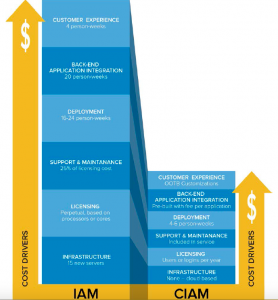— November 21, 2017

Creating content takes time – and if you want to be a valuable piece of content, you need to put in both time and effort. It’s not as simple as throwing words together into sentences to tell a story and calling it a blog post. For the content to have value to your audience, it must tell them something they want to or need to know, but for the content to have value to you, it needs to have SEO value, or value to the search engines, too.
If it doesn’t rank, people will have a hard time finding it. And you want each piece of content you produce to leave a trial around the web so becomes easier for potential customers to find you.
Read this post to learn how Google determines the value of your content, and how going through each of these steps adds more SEO value to each piece of content you create.
How Google Determines Content Value
Algorithm
Though the algorithm changes constantly, there are a couple of human aspects that impact how your content shows up in the search results.
Quality Raters
These are people who manually check search results against quality rating guidelines.
Behavioral Analysis
Google looks at user behavior – like how long people are spending on pages on your website – to determine quality and usefulness.
Keyword Targeting
Always know which keywords you’re optimizing for before you begin writing. As you write, you’ll find ways to naturally work them into the content. It’s not idea to add the keywords in after the fact because you’ll just spend more time rewriting the content to make sure they fit.
Choosing Your Keywords
Choose keywords that don’t have a high level of competition because it will be difficult to impossible to rank for them. The websites that are already ranking for them have an unfair advantage, especially if your website is brand new.
But, at the same time, you don’t want to go for keywords that don’t have a high search volume. Sure, you may rank number one, but if the phrase is only searched about 10 times a month, what’s the point? Unless you have a incredibly niche business, opt for keywords that have at least 100 searches every month.
Keyword Intent
Keyword intent reveals where someone is in the buying stage, and your editorial calendar should feature a mix of content that’s targeted at keywords throughout every stage so you can reach customers at each point in their journey.
Content Headline – Title Tag
This is what users see first, and what will tell Google about your page. Include a keyword within the first 65 characters. If your title is long, put keywords as close to the beginning as possible. Use something like CoSchedule’s Headine Analyzer to get an idea of how well your headline will attract your desired audience.
Body Copy – The Meat of Your Article
While it’s true including keywords throughout your article is important, it shouldn’t be the main focus. Your main focus should be on informing or helping your readers, while the secondary focus needs to be on weaving the keywords into the content naturally.
If you’re stuffing the keywords in the content over and over again, just for the sake of getting keywords in, Google may penalize you for it.
Content Length
There is no such thing as the perfect content length because this is based on what your audience wants. What your audience wants depends on your industry or niche. The length of your content will depend largely on the goals of your content.
In the past, 250 words was enough, but it is now seen as too light to provide real value. Then, 500 words became the new standard. Research shows general blog posts are ideal at around 1,000 words, and heavier hitting posts that want to receive search engine traffic should be around 2,500 words.
Longer isn’t always better. Say what you need to say in as few words as possible, making sure that everything you add provides value to the consumer.
Readability
The content should be readable for the average person, and should be free of spelling and grammar errors. If your content is full of errors, it can not only negatively affect ranking, but also cause your credibility to plummet. Research shows just one spelling mistake could reduce your online sales by half.
URL
Search engines look at the URL of your content to understand what the content is about, so it’s a good place to include keywords. Remove unnecessary information like dates and categories to reduce clutter.
Meta Data
Google says your meta description won’t help you rank higher, but it serves as a free advertisement to your audience because it’s what they see under the link in the search engine results. Make it good, and include the keyword naturally to describe what the reader should expect from the content.
Visual Appeal
Image Choice
Avoid using stock photos where possible, and keep images original when you can. One image is great, but make use of multiple images when you can.
Image Optimization
- Alt tag: Use keywords where possible, but make sure the alt tag accurately describes the picture.
- Title Tag: Use keywords here, too.
- Caption: Accurately describe the photo and use keywords when possible.
- Reduce file size: The smaller the photo, the faster it will load on a page. The faster your page loads, the better for SEO. Make sure you don’t reduce the file size so much that it compromises image quality.
Video Content
Video content is also highly valuable. If you want to increase the SEO value of your piece, strategically share a video that complements the topic.
Sharability
While there’s no direct connection between social media and SEO, when an article resonates with your target audience, it can help you SEO efforts indirectly because people will link to the content, some social media posts will show up in the search engines, and you should see more traffic of conversions since more people are sharing the content.
Metrics to Measure to Determine SEO Value
When you are trying to determine the SEO value of a piece of content, you’ll want to measure:
- The amount of organic traffic it drives
- Its organic rank in the search engines
- The number of leads or conversions it has generated
- The impressions it generates for brand awareness
- The social engagement numbers
- The new subscribers it has helped generate
- Sales/revenue it generates
- The on-site engagement, such as time on site and time on page.
Use Google Analytics to come up with these numbers. Use posts as benchmarks to gauge the performance of new posts.
When you hire us to handle your SEO, our audit will take a look at the SEO value of all your content. Part of our strategy will involve improving the SEO value of existing content and coming up with high value content to add.
Get in touch today to find out how we can help you!
Digital & Social Articles on Business 2 Community
(74)
Report Post





